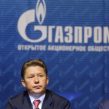
Gazprom’s Investment Strategy Runs out of Steam
Publication: Eurasia Daily Monitor Volume: 6 Issue: 143
By:

Russian state-run gas giant Gazprom has cut its investment program in response to the difficulties it faces in the current economic downturn. These cost-saving measures contrasted sharply with Gazprom’s pledge last year to become the world’s largest company. Such efforts were supported by the Russian government. On July 13, the cabinet approved Gazprom’s revised investment program worth 775 billion rubles ($25 billion) or 15.8 percent down from its 920 billion rubles ($29.7 billion) planned earlier. At a cabinet meeting, Prime Minister Vladimir Putin conceded that Gazprom’s January-June 2009 production was 20.8 percent down year-on-year. However, Putin voiced confidence that Gazprom’s production and sales will return to their pre-crisis levels eventually (Interfax, ITAR-TASS, RIA Novosti, July 13).
According to the business daily Vedomosti, Gazprom’s revised investment program matched its 2007 level or 6 percent down on 2008. Gazprom declined to disclose which specific projects will be suspended, but the delay in the development of the Bovanenkovskoye deposit in Yamal until the end of 2010 would save Gazprom 137 billion rubles ($4.4 billion), Vedomosti noted. Furthermore, Gazprom previously planned to pump 550-560 billion cubic meters (bcm) of gas in 2009 but now it aims to produce only 460-510 bcm (Vedomosti, July 14).
Gazprom’s revised 2009 investment program stipulates reducing its investment in Yamal by 62.4 billion rubles ($2 billion) down to 147.28 billion ($4.7 billion), while increasing its spending in East Siberia and the Far East by 2.6 times up to 64.5 billion rubles in order to prepare for gas exports to Asia-Pacific, according to Kommersant business daily. Gazprom also decided to cut its Shtokman deposit investment from 5.7 billion rubles ($184 million) down to 1.4 billion rubles ($45.2 million), and limit spending on constructing underground gas storage facilities by 3 times down to 4.1 billion and rehabilitating its existing deposits by 2.5 times down to 9.5 billion. However, it plans to increase investment in the Nord Stream pipeline project by 3.5 billion rubles ($113 million) up to 35.9 billion rubles ($1.1 billion) (Kommersant, July 14). In other words, Gazprom appears to be cutting its major projects, while it still funds selected export-oriented programs.
In May 2008, Gazprom CEO Alexey Miller announced that the company was aiming to become the world’s leading corporation. Gazprom’s earlier plan to increase its domestic earnings has also been the subject of revision. On July 13, the Russian government also approved revised regulated gas prices. Gazprom’s regulated domestic gas prices are due to increase by 16 percent this year and by 26.5 percent up in 2010. However, the planned increases fell short of Gazprom’s earlier forecasts, and consequently the company’s planned revenues will decline by an estimated 221-293 billion rubles in 2009-2010 ($7.1 billion). Due to the planned 16 percent gas price increase, Gazprom’s domestic revenues are expected to reach 486-526 billion rubles this year or up from 479 billion in 2008, while export revenues are expected to drop to $40 billion (down from $65 billion in 2008) (Vedomosti, July 17).
Natural gas accounted for 42 percent of Russia’s energy consumption in 1991, but the figure has exceeded 50 percent during the past two years. Gazprom has repeatedly blamed low domestic gas prices for encouraging higher consumption, claiming it had suffered huge losses due to domestic sales at regulated prices. Russia’s domestic gas sales remain strictly regulated by the government, but the cabinet has gradually raised prices. Following Gazprom’s annual general meeting (AGM) on June 26, Miller announced that it aimed to pump 500-510 bcm of gas in 2009. He also suggested that gas production would start at the Shtokman deposit in 2013, and LNG in 2014. "Crises come and go, but Gazprom keeps moving forward," Miller confidently told the AGM (Interfax, ITAR-TASS, RIA Novosti, June 26).
However, the AGM decided to pay a 0.36 ruble per share or 8.5 billion rubles ($275 million) in dividends for 2008, the lowest level in seven years and down from 2.66 rubles per share in 2007. Therefore, Gazprom appeared to be forced to limit its earlier spending spree. Nonetheless, Gazprom still seemed to have some money to spend on purchasing natural gas that the company apparently does not require. On June 29, Gazprom and Azerbaijan’s state-run energy company SOCAR signed an agreement on Azeri gas supplies to Russia. SOCAR agreed to supply 0.5 bcm annually to Russia’s southern regions from January 1, 2010. Subsequently, Miller pledged to eventually increase Gazprom’s purchases of Azeri gas.
Gazprom’s deal with Azerbaijan was apparently aimed at undermining the Nabucco pipeline project, which would bypass Russia and Ukraine, helping Europe find an alternative to Russian supplies. Despite Gazprom’s efforts in Azerbaijan, the Nabucco pipeline deal was signed. However, Russian President Dmitry Medvedev cast some doubt on Nabucco. On July 16, Medvedev argued that Moscow was not jealous about the progress of the Nabucco project, but he voiced doubts as to whether there would be sufficient gas supplies to fill Nabucco (Interfax, ITAR-TASS, RIA Novosti, July 16).
Although Gazprom has apparently moved to limit its excessive spending on development projects and acquisitions, it still appears keen to rely on its earlier checkbook diplomacy in its efforts to undermine competing pipeline projects. However, it remains to be seen whether this capital-intensive diplomacy proves to be economically viable in the current economic climate.




